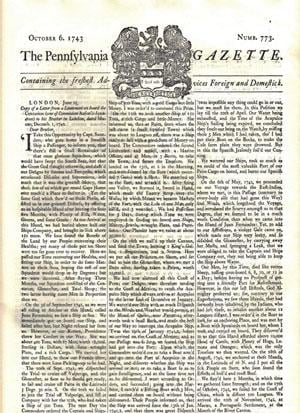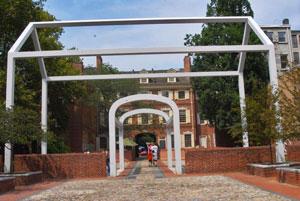Benjamin Franklin is one of the best-known figures in our nation's history'and for good reason. He was a Founding Father, diplomat, statesman, scientist, inventor, writer, and more. At Independence National Historical Park in Philadelphia, you can learn first-hand about another of his skills'expert printer'at the park's Franklin Court Printing Office.
Rangers at Franklin Court use a replica 18th-century printing press to demonstrate the methods the famous writer used to literally put his own words on paper, and through December 18, they've taken on a special project: hand-printed reproductions of the October 6, 1743, edition of Franklin's Pennsylvania Gazette newspaper. Copies are available for purchase by park visitors.
Franklin took over the Pennsylvania Gazette in 1729 when it was an ailing paper, dull and poorly managed. According to a park spokesperson, the printer and writer "applied his signature wit, intelligence and determination and soon the Gazette was recognized throughout the colonies as an informative and entertaining paper."
News Headlines, 1743 Version
What made the news on October 6, 1743?
Along with local news and advertisements, that day's edition of the Pennsylvania Gazette features a letter from a lieutenant on board HMS Centurion with reports about Commodore George Anson's circumnavigation of the globe in pursuit of enemy ships and Spanish treasure. The paper offers a clear reminder that in 1743, we were still very much a part of the British Empire.

The October 6, 1743, edition of Franklin's Philadelphia Gazette. NPS image.
A park publication notes that "Franklin's publishing credits went beyond the news, as he innovated the publishing industry. He used cartoons and maps to illustrate his articles. He printed his political theories to gain public support. He shared his witty and wise sayings in Poor Richard's Almanac."
Franklin's Important Skills as a Printer
The park's print shop demonstrations help visitors learn about Franklin's skill as a printer, an aspect of his life that is often overshadowed today by his many other accomplishments. It was, however, an important part of his development as a mover and shaker in American life in the mid-18th century.
A Library of Congress exhibit about Franklin notes, "He was considered the most accomplished printer in Colonial America. His 1744 edition of Cicero's Cato Major . . . is the finest example of early American printing.... Franklin's newspaper The Pennsylvania Gazette, his Poor Richard's Almanack, and work as an inventor and scientist propelled him to the front ranks of Philadelphia society and made him a well-known figure throughout the American provinces and England."
Franklin's Printing Office Demonstrates 18th-Century Technology
Franklin's printing office at 2nd and Market in Philadelphia no longer stands, but visitors to Franklin Court can see what his office might have looked like and observe demonstrations of 18th-century printing, using type almost identical to Franklin's original.
That process is possible due to the craftsmanship of Richard Hopkins of Hill & Dale Typefoundry in Terra Alta, West Virginia. Using equipment that had been disposed of by other type foundries as 'obsolete,' Hopkins hand-crafted each piece of type into the Caslon font. The font used to print the Dunlap broadside (the first printed edition of the Declaration of Independence), Caslon was a font favored by Franklin and is still available in some computer programs today.

The Caslon font was a favorite of Franklin for his printing business. Image from Wikimedia Commons.
The font was developed in 1722 by William Caslon I (1692 ' 1766), a British engraver, type designer and printer, and is considered by some to be the first original typeface of English origin. Franklin's preference for a contemporary font with British roots is especially appropriate given his own background in the trade.
Franklin went to work at the age of 12 as an apprentice in a Boston print shop owned by his older brother James, and by 1723, at the age of 17, he was living in Philadelphia, one of the largest cities in the American colonies. There he continued to work as a printer and made many friends in the trade.
Franklin's London Printing Connections
One of those friends, Sir William Keith, Governor of Pennsylvania, convinced the young Franklin to move to London, where he went to work at two of the most prestigious printing firms in the city. Perhaps it was during those years that he became acquainted with the Caslon font.
In October 1726, Franklin returned to Philadelphia and continued his trade as a printer. By the age of twenty-four he was running his own business, and in 1729, he bought the Pennsylvania Gazette. A park publication notes, "Ben's philosophy for success, work harder than your competition, drove the success of the paper as it gained recognition throughout the colonies."
The reproduction of the 1743 Gazette is a complete printing of all four pages included in the original edition. Due to the time and effort required for a project of this scope, the park does not usually recreate entire newspapers, and this unique publication will only be printed through December 18, 2013. After that date, the historic printing office will once again produce copies of the Declaration of Independence and famous Franklin quotes.
Franklin's Home is Suggested Today by a "Ghost Structure"
Franklin Court, which includes the Printing Office, was the site of the handsome brick home of Benjamin Franklin, who lived here while serving in the Continental Congress and the Constitutional Convention. Franklin died here in 1790; the house was torn down about 20 years later.

This steel "ghost structure" marks the site of Franklin's original house. NPS photo.
In addition to the Printing Office, Franklin Court now contains a steel "ghost structure" outlining the spot where Franklin's house stood and features the Benjamin Franklin Museum, a new museum that explores Franklin's life and character through artifacts, animations, and hands-on interactive exhibits.
The Franklin Court complex also houses an architectural/archeological exhibit and an operating post office'an appropriate reminder that Franklin was the first Postmaster General appointed by the Continental Congress in 1775.
Visiting Franklin Court
During the month of December, the Benjamin Franklin Museum at Franklin Court is open daily from 9 a.m. to 5 p.m., and the Printing Office is open daily from 11 a.m. to 5 p.m. (except Christmas Day). Those attractions are located just a two-block walk from both Independence Hall and the Independence Visitor Center. You'll find details to help plan a visit to Independence National Historical Park, including a park map, here.
If a visit to the park and a chance to see the 18th century print shop isn't part of your upcoming schedule, you can still see an excellent demonstration of those printing techniques via the following short video. Given his love for both innovation and communication, I suspect Franklin would be pleased with the idea that such information can be so easily shared with people around the world today.


 Support Essential Coverage of Essential Places
Support Essential Coverage of Essential Places







Comments
I seriously want to have a copy of this...
In response to a couple of e-mail inquiries, I checked with the park today, and due to the limited number of copies they are able to print on a daily basis and the demand, copies are unfortunately only available for purchase on-site. The employee I spoke with said this project has generated a lot of interest by the public.